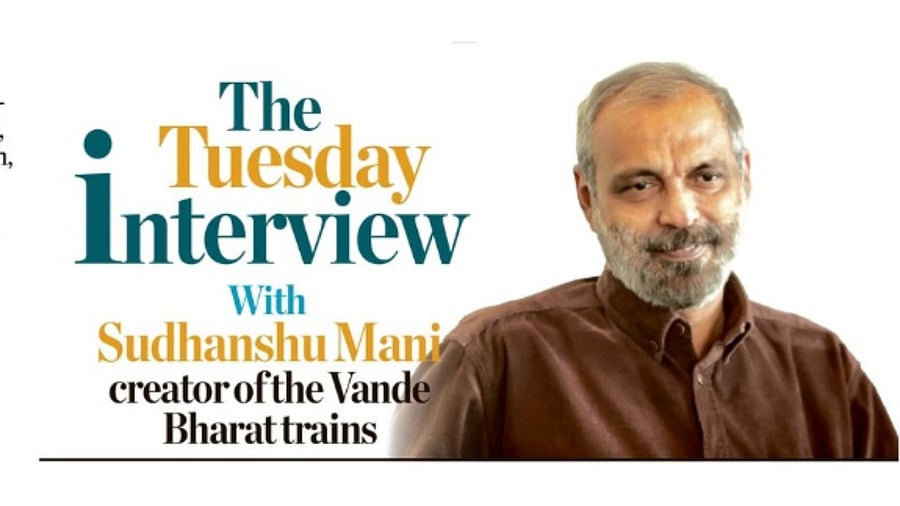
'Vande Bharat was thought of as a train which would practically compete with air. With that aim, for a journey of up to six hours, it may become a preferred option. So, fare is not an issue and has to be higher because you’re competing with air.'
Credit: DH Illustration
While Vande Bharat Express, designed to compete with air travel, is fast expanding its reach, the promise of faster travel has not been realised with an average speed as low as 70 kmph on some routes.
The creator of Indian Railways’ Vande Bharat trains, Sudhanshu Mani, sat down with DH’s Lavpreet Kaur and Arup Roychoudhury to talk about the reason behind the low average speed of the trains and other issues.
Excerpts.
Passengers pointed to lower-than-potential speed on Vande Bharat trains. What is the reason for this?
When you design, you design with certain boundary conditions. We decided to design and make a train which should be able to run at 160 kmph in commercial operations, and the average speed should be above 100 kmph so we could save at least an hour of travel time. Since the train has very good acceleration and deceleration, it was able to cut down the Delhi-Varanasi travel time by more than 20 per cent at an average speed of 96 kmph. None of the other 27 or 28 Vande Bharat trains introduced since have achieved that average speed. In some cases, it is even below 70 kmph. So, the promise has not been realised the infrastructure has not kept pace with the train made five years ago. It is not easy to upgrade infrastructure. It needs coordination between many teams, execution contracts, time and money. Money is not a problem, the contract execution to upgrade the tracks is.
Infrastructure has no visibility, trains have. And a lot of it is led by the interest shown by the Prime Minister in launching each and every train. So, the train has become the focus, but work on the infrastructure itself is very gradual.
The Vande Bharat fares are quite high for the common man. Can we expect them to come down?
Vande Bharat was thought of as a train which would practically compete with air. With that aim, for a journey of up to six hours, it may become a preferred option. So, fare is not an issue and has to be higher because you’re competing with air.
Has Railways, in its efforts to push for semi-high speed trains, forgotten the basics of its role as a transporter?
When it comes to the common man, assuming we become a developed country in some years, look at the picture of how we carry people. The poorer people of the country travel like cattle. Is that something you will ever see in a developed country? No! So, when do you start doing something about it? When those people have more money in their pockets, three or four times what they have currently, or do you start preparing for it now?
You see, of late, a number of non-AC coaches, general class, have been reduced and instances of general class travellers crowding AC 2-tier, 3-tier coaches which have reserved passengers have gone up. It’s a bad sign. Money is not a problem, so make as many trains as possible which have 24 coaches. Of course, parts are expensive. Once I put a train through, it should carry the maximum number of coaches. This needs more focus from the government to cater to the non-elite 95% of its passengers. Their travel (experience) has become worse than it used to be. They are the people who have no option but to travel by rail, and this belief that they will anyway travel and you don’t need to take care of them is very selfish.
On the safety front, how safe are the current LHB (Linke Hofmann Busch) coaches in comparison to the coaches by Integral Coach Factory?
One is, of course, safety related to infrastructure, and KAVACH is a part of that. There is one part of it which is installed in the train but it looks like the way Kavach is being installed, it is going to be a waste for long. It is just sitting on the train.
The train itself has many features in case of a crash, the crashworthiness is better than LHB coaches. It does not have a tendency to topple. It has safety features similar to LHB, plus other features like microprocessor-controlled improved braking system, in which the braking distance for the lower, automatic doors that won’t open when the train is moving. So, I wouldn’t say it has great safety features, but incremental improvements for sure.
What are your thoughts on the privatisation and monetisation of assets in Indian Railways?
A mix of private and public is needed keeping in mind the common-man focus. The Railways attempted private train operation, but it was framed in a manner so skewed in favour of Railways that private operators didn’t show interest. Privatisation of ConCor is on the cards and we may see that happen after next year. But again, it is also two steps forward, one step back -- it’s never in favour of the private operator. The supplicant-dispenser of favour relationship won’t work, it has to be a partnership. That, bureaucracy has to change.
Moreover, Railways has really not been able to do asset monetisation. The PPP model has failed. It can be done, but Railways has not been able to do that efficiently. Moreover, Railways’ finances are in a very poor state, though the capex is high. So, it is the need of the hour to monetise the assets. We have to look at a new model, because left to the railway bureaucracy alone, it is not going to work.